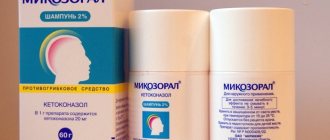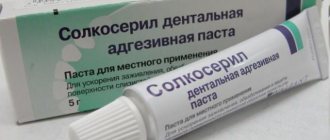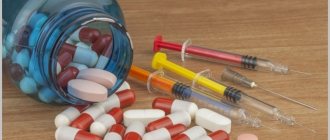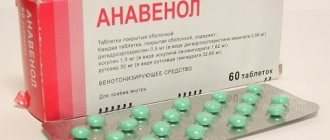Pharmacological properties of the drug Venter
A remedy for the treatment of peptic ulcers. Sucralfate protects the gastric mucosa without having a systemic effect and having virtually no effect on the acidity of gastric juice. Sucralfate binds to the proteins of necrotic tissue in the area of the ulcer, forming a protective coating that prevents the action of pepsin, hydrochloric acid of gastric juice and bile salts. Sucralfate reduces pepsin activity by approximately 30%. Accelerates the scarring of peptic ulcers of the stomach and duodenum, prevents their recurrence and the formation of stress ulcers, and also reduces the absorption of phosphates from the digestive tract. After oral administration, ≤5% of sucralfate is absorbed, as a result of which the drug has no systemic side effects. The absorbed part of the drug is excreted by the kidneys.
Use of the drug Venter
Orally on an empty stomach 30–60 minutes before meals. The tablets can be swallowed whole with water, or, like the granules, dissolve them in 1/2 glass of water and drink the resulting solution. For peptic ulcers of the stomach or duodenum, 1 g is prescribed before each main meal (breakfast, lunch, dinner) and 1 g before bedtime. You can also prescribe 2 g 2 times a day. The duration of treatment should not exceed 12 weeks. If the symptoms of the disease disappear, the drug should be continued for another 4–8 weeks or until the result of an endoscopic examination confirms scarring of the ulcer. To prevent relapses of duodenal ulcers, 1 g is prescribed 2 times a day. Children over 4 years of age can be prescribed 0.5–1 g of sucralfate 4 times a day (1 hour before each main meal and before bedtime), that is, approximately 40–80 mg/kg body weight in 4 divided doses . There is no need for dose adjustment in patients with renal failure. There is a risk of aluminum accumulation in the body when using the drug in patients with chronic renal failure or in patients on dialysis.
Antepsin (analogue of Venter) tab. 1 g No. 60 - Instructions
Compound
The main active ingredient is sucralfate at a dose of 1 mg per tablet.
In addition, the composition includes: macrogol 6000, microcrystalline cellulose, calcium carmellose, magnesium stearate.
Release form
The drug is available in the form of biconvex, oblong, white tablets with a dividing line on one side. Packs of 60 pieces.
pharmachologic effect
Sucralfate works locally. As a result of its protective effect on the gastric mucosa, it accelerates the healing of ulcers. This is because it causes local production of prostaglandins and epidermal growth factors. At the site of injury, sucralfate binds to the mucosa due to electrostatic interactions between positively charged proteins in the exudate and negatively charged drug ions. Thus, a special protective shell is created over the ulcer, preventing the penetration of hydrogen ions. Sucralfate binds gastric enzymes and bile acids. Thus, it protects the ulcer niche from the acidic components of digestive juices.
Pharmacokinetics
Sucralfate is poorly absorbed from the gastrointestinal tract after oral administration. This is about a few percent. In the acidic environment of the stomach, a small amount is broken down into aluminum hydroxide and sucrose octosulfate. The aluminum ions released as a result of dissociation partially combine with the phosphates present in the stomach to form slightly soluble or completely insoluble salts, which are only slightly absorbed. On the other hand, free aluminum ions in the acidic environment of the stomach bind to positively charged proteins in the gastric mucosa. Under the influence of hydrochloric acid, sucrose sulfate is also formed, which is not metabolized.
Neither sucralfate nor the sucrose sulfate formed from it is metabolized in the stomach under the action of hydrochloric acid, nor aluminum.
Extraction occurs mainly through the gastrointestinal tract. A small percentage (less than 2%) is excreted in the urine through the kidneys. On the other hand, sucrose sulfate, formed under the influence of hydrochloric acid, is almost completely (more than 90%) excreted unchanged in feces.
Indications for use
Peptic ulcer of the stomach and duodenum is an indication for the use of Antepsin.
Contraindications
If you are hypersensitive to the composition of the drug, it should not be used.
Antepsin should not be used long-term in patients with severe renal failure, uremia, or disease states with low levels of inorganic phosphate in the blood.
The drug is contraindicated in patients on dialysis. These patients may experience aluminum accumulation in the body and its toxic effects (osteodystrophy, osteomalacia, encephalopathy).
Uremia and hypophosphatemia are also contraindications to the use of this drug.
Side effects
Most often, the drug can cause the following negative reactions: dry mouth, nausea, rash, formation of an insoluble mass in the intestines (bezoar).
Drug interactions
Antepsin is a drug containing aluminum, so during treatment they should limit the use of other drugs containing this element to avoid its accumulation in the body.
In addition, antacids should be taken 30 minutes before taking the drug.
Concomitant use of Antepsin may reduce the bioavailability of certain drugs, including fluoroquinolones such as ciprofloxacin and norfloxacin, tetracycline, ketoconazole, sulpiride, digoxin, warfarin, phenytoin, theophylline, levothyroxine, quinidine and antagonists. The bioavailability of these agents can be restored by separating the administration of these agents from Antepsin by two hours.
Because of Antepsin's ability to alter the absorption of some drugs from the gastrointestinal tract, separating Antepsin administration from other agents should be considered when changes in bioavailability are considered critical for concomitantly administered drugs.
Taking Antepsin with food can increase the bioavailability of the drug. This is due to the fact that the drug can bind to food proteins. Therefore, it is recommended to use the drug one hour before meals or two hours after it.
Application and dosage
Antepsin should be taken in the morning on an empty stomach, half an hour to an hour before the first meal.
When treating stomach and duodenal ulcers, the therapeutic dose is 4 g. The medicine should be taken 30-60 minutes before main meals and immediately before bedtime, with plenty of water or dissolved in water. Duration of treatment is 4-6 weeks. You can take a maximum of 8 g per day.
For peptic ulcers, up to 4 g of Antepsin per day should be taken for at least 4-8 weeks or until the ulcer has healed.
In patients with renal failure, the dose should be adjusted after consultation with a specialist physician.
Children over 4 years old are prescribed up to 4 g per day, i.e. 320 mg per kg body weight per day.
Overdose
There are no specific symptoms of Antepsin poisoning. In case of overdose, aluminum salts can accumulate in the body and have a toxic effect on the body.
Therapy is carried out in accordance with the emerging symptoms.
special instructions
Antepsin can bind to dietary proteins and some medications and therefore may cause the accumulation of undigested substances (intestinal stones) in patients with slow gastric transit. The situation is similar for people fed through a nasogastric tube. Therefore, such patients should receive the drug after a significant period of time compared to food and other medications.
Due to insufficient data on the safety of Antepsin in children under 14 years of age, use of the drug in this age group is not recommended.
Use during pregnancy and breastfeeding
Antepsin should not be used during pregnancy. The exception is when the doctor considers such therapy absolutely necessary.
Breastfeeding women should not take medications containing sucralfate.
Impact on the ability to drive vehicles and operate machinery
It has not been observed that the use of Antepsin negatively affects the ability to drive vehicles and operate machinery.
Storage conditions
At temperatures up to 25 degrees Celsius. The shelf life is 3 years.
Terms of sale
On prescription.
Special instructions for the use of the drug Venter
The small amount of aluminum contained in sucralfate is absorbed in the digestive tract and subsequently excreted in the urine. In case of severe renal dysfunction, aluminum may accumulate in the body with the development of its toxic effect. The risk of accumulation increases with simultaneous administration of other drugs containing aluminum (for example, some antacids). The safety and effectiveness of sucralfate in children under 4 years of age have not been sufficiently studied, so it is not recommended to prescribe the drug to children in this age group. The drug can be used during pregnancy only when the expected benefit to the expectant mother outweighs the potential risk to the fetus. There is no evidence that sucralfate passes into breast milk, so it should be used with caution during breastfeeding.
Venter tablets 1g No. 50
Compound
Active substance: sucralfate 1 g.
Excipients: corn starch, talc, colloidal anhydrous silicon dioxide, magnesium stearate.
Pharmacokinetics
Sucralfate is poorly absorbed (5% disaccharide component and less than 0.005% aluminum [Al3+]) from the gastrointestinal tract and therefore does not have significant systemic effects. A small amount of sucralfate (3-5%) is excreted from the body by the kidneys.
Indications for use
- Peptic ulcer of the stomach and duodenum in the acute phase.
- Prevention of exacerbation of duodenal ulcer.
- Hyperphosphatemia in uremic patients on hemodialysis.
- Reflux esophagitis.
- Prevention of stress ulcers.
Contraindications
- Severe renal dysfunction.
- Children under 14 years of age (efficacy and safety have not been established).
- Hypersensitivity to sucralfate and other components of the drug.
With caution: chronic renal failure (CRF) (due to the risk of aluminum intoxication), pregnancy, breastfeeding.
Directions for use and doses
Orally, without chewing, with a small amount of water, 1 hour before meals and before bedtime.
Peptic ulcer of the stomach and duodenum in the acute phase
Orally, 1 tablet (1 g) 4 times a day or 2 tablets (2 g) 2 times a day. The maximum daily dose is 8 g. The average duration of treatment is 4-6 weeks, if necessary - up to 12 weeks.
Prevention of exacerbations of duodenal ulcer
1 tablet 2 times a day.
Reflux esophagitis
1 tablet 3 times a day before each meal and 1 tablet before bed.
Hyperphosphatemia
1 tablet 4 times a day before meals and before bed. In patients with hyperphosphatemia, when plasma phosphate concentrations decrease, the dose of sucralfate may be reduced.
The duration of therapy for reflux esophagitis, hyperphosphatemia, as well as the duration of use of sucralfate for the purpose of preventing exacerbations of gastric and duodenal ulcers is determined by the clinical condition of the patient and the results of an examination over time by the individual attending physician.
Children
The safety and effectiveness of sucralfate in children under 14 years of age have not been established, and therefore its use in this age category is contraindicated. The available data are described in the section “Pharmacological properties” (subsection “Pharmacodynamics”).
Storage conditions
At a temperature not exceeding 25 °C, in the original packaging. Keep out of the reach of children.
Best before date
3 years. Do not use the drug after the expiration date.
special instructions
In case of insufficiency of renal function, monitoring of the concentration of aluminum and phosphates in the blood serum is necessary. The risk of aluminum accumulation in the body increases with simultaneous use of drugs containing aluminum (some antacids).
Administration of sucralfate through a nasogastric tube may result in the formation of a bezoar (a pellet-shaped stone formed in the digestive tract) with other drugs or enteral feeding solutions (may bind protein).
Cases of bezoars have been reported after the use of sucralfate, mainly in critically ill patients in intensive care units. Most patients (including neonates, in whom the use of sucralfate is not recommended) either had a predisposition to the formation of bezoars due to an underlying disease (condition) (for example, delayed gastric emptying due to surgery or the presence of diseases leading to decreased peristalsis), or received concomitant enteral nutrition (via tube).
Description
Gastroprotective agent.
Use in children
The safety and effectiveness of sucralfate in children under 14 years of age have not been established, and therefore its use in this age category is contraindicated. The available data are described in the section “Pharmacological properties” (subsection “Pharmacodynamics”).
Pharmacodynamics
By interacting with the proteins of necrotic tissue of an ulcer or erosion, sucralfate forms a protective layer that, over a long period of time, protects the affected areas of the mucous membrane from the influence of aggressive factors (hydrochloric acid, pepsin and bile acids).
Moderately (30%) inhibits the activity of pepsin and also reduces the absorption of phosphates from the gastrointestinal tract. Children
There is limited clinical data in the literature on the use of sucralfate in children (mainly for the prevention of stress ulcers, reflux esophagitis and mucositis).
The dose of sucralfate used was 0.5-1 g 4 times a day (depending on the age of the children and the severity of the underlying disease), the use in these cases was not accompanied by serious problems in terms of the safety profile. However, due to limited data, the use of sucralfate in children under 14 years of age is currently contraindicated.
Side effects
Constipation; rarely - nausea, vomiting, diarrhea, flatulence, dry oral mucosa, bezoar, headache, insomnia, drowsiness, dizziness, gastralgia, lumbar pain, allergic reactions (itching, skin rash, urticaria).
Use during pregnancy and breastfeeding
The safety of the drug during breastfeeding has not been established.
Use during pregnancy is possible if the benefit to the mother outweighs the potential risk to the fetus.
Interaction
If it is necessary to prescribe sucralfate and antacids simultaneously, the latter should be taken 30 minutes before or 30 minutes after taking Venter.
Sucralfate reduces the absorption of tetracyclines, cimetidine, ranitidine, ciprofloxacin, norfloxacin, ofloxacin, digoxin, indirect anticoagulants and theophylline (the interval between their administration should be at least 2 hours).
Reduces absorption and the indicator of equilibrium concentration of phenytoin (possible resumption of seizures). The interval between doses should be at least 2 hours.
Overdose
The risk of overdose is unlikely.
Symptoms: nausea, vomiting, epigastric pain.
Treatment: symptomatic.
With long-term use of large doses, in case of renal failure, aluminum intoxication may develop, up to the development of encephalopathy (dysarthria, apraxia, myoclonus, dementia, convulsions, in severe cases - coma and death) and osteomalacia (pain, pathological fractures and bone deformation) .
Treatment: discontinuation of the drug Venter, hemodialysis, hemofiltration, peritoneal dialysis and the use of deferoxamine.
Impact on the ability to drive vehicles and operate machinery
There were no reports of significant effects on the ability to drive a car or use other machines.
Venter drug interactions
Antacids can be prescribed during treatment with sucralfate, but they should be taken at least 30 minutes before taking sucralfate or 1.5 hours after taking it. Medicines containing aluminum compounds (for example, some antacids) may cause aluminum to accumulate in the body in patients with kidney failure. Sucralfate may reduce the absorption of certain drugs, such as tetracycline, cimetidine, ranitidine, fluoroquinolones, digoxin, theophylline, warfarin, ketoconazole, levothyroxine, quinidine and phenytoin. These medications should be taken at least 2 hours before taking sucralfate. Sucralfate may bind to some food proteins. For patients being fed by gastric tube, sucralfate should be administered separately from food and other medications.




